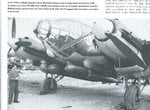Airframes
Benevolens Magister
Does anyone have definitive information as to exactly when the H-4 variant entered service with the Luftwaffe ?
In various books I've been studying, this variant is shown as entering service, or at the very least replacing the H-3 variant in production, on periods ranging from '..early 1940', to 'early 1941', with at least one source being more specific, and quoting '.... from early September, 1940'.
However, various photos in these books purport to show the H-4 variant, with individual exhaust stubs, rather then the 'flame damper' type of tubular, 'collector' exhaust seen on the H-1, H-2 and H-3, at periods variously described as July and August 1940, and 'summer 1940', with units based in Northern France, and Norway.
Also, crash and interrogation reports (of downed aircrew) concerning aircraft used by KG26 (based at Stavanger, Norway) on the raids against north east England on 15th August, show the codes of the aircraft concerned, which are described as He-111H-4, as do the listings of these aircraft in three books on the subject, where at least some of the information has come from accounts by the surviving aircrew involved.
That said, at least one photo of one of the aircraft lost on that day, shows that the earlier, 'tubular' exhausts are fitted (perhaps still retained by the first production batch, before the up-grading of the engine type ?), whereas I understand that the H-4 had the individual exhausts stubs.
Any info will be gratefully received.
In various books I've been studying, this variant is shown as entering service, or at the very least replacing the H-3 variant in production, on periods ranging from '..early 1940', to 'early 1941', with at least one source being more specific, and quoting '.... from early September, 1940'.
However, various photos in these books purport to show the H-4 variant, with individual exhaust stubs, rather then the 'flame damper' type of tubular, 'collector' exhaust seen on the H-1, H-2 and H-3, at periods variously described as July and August 1940, and 'summer 1940', with units based in Northern France, and Norway.
Also, crash and interrogation reports (of downed aircrew) concerning aircraft used by KG26 (based at Stavanger, Norway) on the raids against north east England on 15th August, show the codes of the aircraft concerned, which are described as He-111H-4, as do the listings of these aircraft in three books on the subject, where at least some of the information has come from accounts by the surviving aircrew involved.
That said, at least one photo of one of the aircraft lost on that day, shows that the earlier, 'tubular' exhausts are fitted (perhaps still retained by the first production batch, before the up-grading of the engine type ?), whereas I understand that the H-4 had the individual exhausts stubs.
Any info will be gratefully received.

